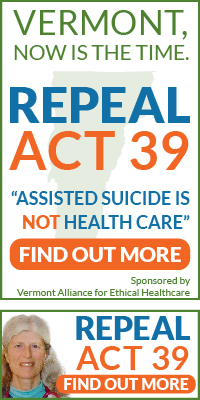Two stories were in the Vermont news this week that highlight a very real conflict of interest over suicide in this State.
Vermont Public Radio aired an interview with JoEllen Tarallo-Falk, Director of the Vermont Suicide Prevention Center (VTSPC), on suicide prevention: http://digital.vpr.net/post/more-funding-needed-suicide-prevention-advocates-say
Meanwhile, several media outlets published stories glamorizing two recent Legislature-endorsed (per Act 39, “Physician Aid-in-Dying”) suicides in Vermont, which have been promoted as part of a public relations push by proponents of Act 39, to gain support for the law. The effort is fueled by an acknowledgment of serious deficiencies in the law which proponents see as roadblocks to getting support from physicians, nursing homes and pharmacists, and which they erroneously claim can be fixed with a few changes.
In the VPR interview, Tarallo-Falk said that the VTSPC will be asking the Legislature for funding of $750,000 to help support ongoing suicide prevention efforts. She reported an alarming increase in the number of suicides in the last 10 years in Vermont, whose suicide rate is well above the national average. Thanks in part to federal funding, an aggressive effort to deal with the problem and to identify people at risk for suicide has included the training of over 1400 individuals and outreach to numerous schools and institutions throughout the State. The federal funding will soon end and the VTSPC hopes new State funding can come from Education, Health Care and Human Services budgets.
The efforts of the VTSPC are commendable and to be supported. But their request poses a conflict of interest for the Legislature. To promote suicide prevention treatment for some groups while at the same time supporting suicide for one significant and vulnerable population—those who have terminal illnesses—is discrimination of the worst kind. But the reality is that the attitude toward the terminally ill in Vermont has already shifted to one of “helping” them kill themselves, rather than evaluating whether suicide prevention efforts might help them live out their lives in comfort and a state of positive mental health.
Studies reveal that among the elderly, a key reason for suicide is chronic pain. Because the proponents of assisted suicide have worked hard to use the fear of pain as a justification for assisted suicide, it is not hard to imagine that any elderly person with a chronic condition may receive a referral for “aid in dying” rather than suicide prevention treatment, along with better pain management, that might be of greater ultimate help to that person.
Tarallo-Falk noted that economic worries and concerns about being able to adequately care for loved ones is a key factor among some populations at risk for suicide. It is easy to imagine that a person with a terminal illness, or an elderly person in frail health, might also worry about the depletion of financial resources related to his care; does this person merit suicide prevention treatment, or a prescription to kill himself? Who decides?
According to the VTSPC, another factor that increases a person’s risk of suicide, is being related to someone who has died by suicide. Act 39 cannot change the definition of suicide by merely giving it another name. We must acknowledge the risk and reality of suicide contagion as a direct result of this law, and as a result of each glamorized media portrayal of its use. The Centers for Disease Control long ago cautioned the media against romanticizing suicide because doing so may contribute to suicide contagion (http://www.cdc.gov/mmwr/preview/mmwrhtml/00031539.htm). The existence of suicide clusters is well known and reported, and counselors are routinely sent into schools in which a student has committed suicide to try to offset the possibility of suicide contagion.
In Oregon, where assisted suicide has been legal since 1998, the suicide rate among all populations has risen steadily, raising concerns about suicide contagion. The rate of non-assisted suicides in the state, which had been declining for a decade prior to legalization of assisted suicide, immediately began to rise. It has continued to do so. In 2010 it was 35% over the national average (http://www.oregon.gov/DHS/news/2010news/2010-0909a.pdf. By 2012, it was 41% over the national average (https://www.deschutes.org/DeschutesOrg/files/33/33d5338f-6e71-49ca-b6fa-051ac3293a8b.pdf).
Similarly, Washington State legalized assisted suicide in March 2009, five and a half years ago. Now we read that the non-assisted suicide rate is rising there as well. (http://mifflin.pa.networkofcare.org/mh/news-article-detail.aspx?id=54947).
We already know that Vermont’s suicide rate is alarming. Do we really wish to work against valid efforts to decrease it?
The distinction between people whose situations call for “suicide prevention intervention” and those whose expressed desire to die leads to a prescription to die, will become increasingly arbitrary, and the decision to treat may well come down to the subjective judgment of people other than the person who is sick.
Adding safeguards to Act 39 will not solve these and numerous other problems inherent in the Law. No additions or changes to Act 39 can ever make it free of risk from abuse and error. Abuse and error that result in death, which is final, cannot be tolerated.
Suicide prevention is a laudable cause which we should all support. Act 39 is a dangerous piece of legislation which should be repealed.

